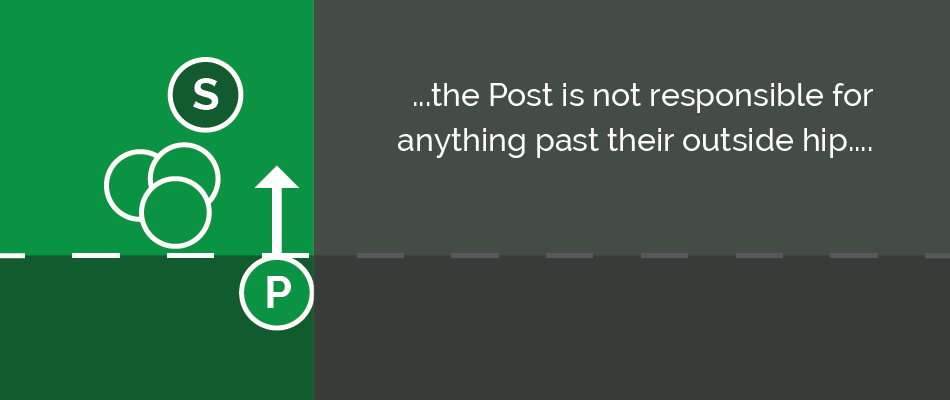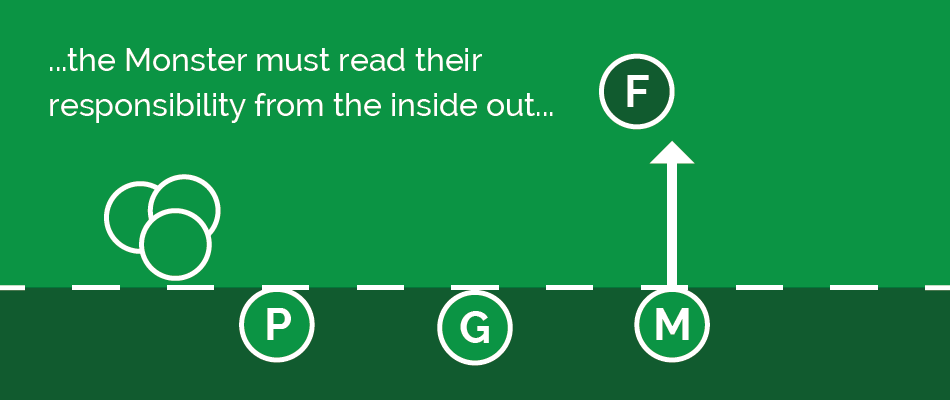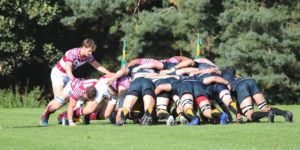Rugby season is just almost here! College teams are starting to assemble. Creating a dominant team in 2016 will mean having a rock-solid defense.It all starts with structure. Luckily for us, David Weitz is back after his excellent work detailing how to coach rugby using a zone system.
Today, David explains how to name and structure your defensive unit from inside-out. That is, based on defending the breakdown first and forcing the opposition to go around you.
Defending the field
One of the standing rules of defense in rugby and many other sports is to take away the most direct scoring path from the opposition.
In rugby, this is done by forcing the attacking team to move the ball wide. The first step to ensuring this happens is to shut down any attacking lane directly next to the breakdown (ruck, maul or tackle).
By forcing the attack to move the ball wide, two things are accomplished. First, the attacking team must transfer the ball between players multiple times, usually in the form of passes but potentially using a kick. This allows the defense more time to cover the attack and more chances for the attacking team to make a mistake. Secondly, and possibly most importantly, it creates a base from which the defense can operate. Ruck defense is the heart of the defense and creates a framework for the rest of the defensive structure.
The most common way to defend the breakdown is by establishing three defensive roles. These three roles can be occupied by any player and should serve to shut down any attack at the base of the ruck and set the tempo and structure for the rest of the defense. The three roles have many different names, I learned it as Post, Guard and Monster. Other terms include:
- Pillar, Post Key
- A, B, C
- Guard, Shield, A
In the end, it doesn’t matter what the three players are named, what’s important is that they communicate their role, understand their assignment and know how it fits into the team’s defensive structure. The only sign in the Patriots locker room is a simple sign “Do your job” a defensive structure in rugby works the same way. If everyone does their job, the defense is sound.

Post
The defense is built around the Post. This is the first player directly next to the ruck. The Post has a very simple role but if it is not completed the attack has a direct line to the Try Zone. The heart of the Post’s job is to allow the rest of the defense to focus on potential receivers and not worry about the ruck.
The Post’s defensive responsibility is to shut down any run coming from one yard outside of the ruck in towards the ruck. It’s critical that he/she is focused only on this job and takes a selfish, borderline lazy role during this time. This player’s responsibility is not to be the primary tackler of ball runners who may receive the ball from the scrumhalf. More on those roles later. Instead, their singular focus should be on the halfback and anything inside the halfback.
One of the most common tackles the Post will make is against a “pick and go”. Regardless if the pick and go is a quick pick looking to shoot the gap or from a group of forwards looking only to cross the gain line, the post must tackle the ball carrier back towards the ruck. If they allow the attacker to cross the gain line, the rest of the defense will be forced to retire behind the last feet to be on-side. While they are doing so, a quick ball can give the attack advantage and have the defense playing catch up.
The Post is critical to stopping the scrumhalf from running and distributing the ball. Beyond stopping any inside threat, the Post will also stop any runner from crossing in front of them. This means that if the scrumhalf picks up the ball and runs sideways it is the Post’s job to come up and tackle them back into the ruck before any inside gap appears. If the scrumhalf is picking and running several steps before passing this can be an effective way of stopping this move. The other move this rule is designed to stop is when the scrumhalf runs directly sideways and gives the ball to a forward on a switch. The Post should shut down the scrum half’s run before they are able to open a lane up for a forward to get through.
Also, to cover the gap directly next to the ruck the Post is responsible for calling the defense up. The Post’s eyes are fixed on the ball and the second the scrumhalf plays the ball the Post should be calling “Up” to signal the rest of the team to move forward. By covering this gap and calling when the ball is out the Post allows the rest of the team to forget about the ruck and focus on potential runners.
The Post has a very specialized role, and their stance and body position should reflect this. The Post is not responsible for anything past their outside hip. As a result, they should have their outside foot forward. This allows the Post to turn their hips into their assignment (the channel right next to the ruck). When the player’s hips are turned in towards the ruck, they are more powerful against a pick n go, and they have a better view of the ball. Another added benefit of having the outside foot forward is that they are less inclined to drift outside. The Post should be watching the ball, and when it is moved, they should step forward with their inside foot towards the scrumhalf.
If the scrumhalf runs with the ball the Post should immediately tackle him directly onto the previous ruck. If the scrumhalf passes the ball, the Post should take his same steps and prepare for any inside runner. In the event of a tackle situation outside the Post’s outside shoulder, they should be in a position to poach or help counter ruck. If the ball continues to move wide, the Post will join the defensive line in the back hip of the Guard.

Guard
The Guard is the 2nd player away from the Ruck, immediately alongside the Post. The Guard serves to connect the Post and the Monster. The Guard is aligned up directly outside of the Post with their inside foot forward and their eyes up to look for any threats. Once the guard hears a call of “I’m Post” from their inside, they should never need to look inside because they know the Post has that channel shut down. This allows the Guard to keep their eyes up and away from the ruck and focused on any attacking threats.
The Guard’s job is to shut down the channel from the Post to the Monster. This is usually occupied by a forward looking to run a crash ball. It’s critical that the Guard comes up and attacks this runner. If they hesitate on the runner, two negatives situations will result.
The first, and most obvious, is that the runner will break the gain line. Crossing the gain line makes winning possession at the ensuing ruck much easier for the attacking team. It also creates a cleaner path from the scrumhalf which by extension speeds up the play. At the same time, the defense will need to retire to remain onside. As the defensive side is moving backward behind the new offside line, the attack has the advantage of moving forwards and gaining momentum.
The second part plays into the Guard’s role as the determiner of line speed for the defense. The Guard is the only player who can move forward in defense past the player inside of them 100% of the time. The rest of the players should remain a step behind the inside player. If the Post player is slow to come up, there are two possible options: The first result would be that the Monster and the rest of the defense would stay back and give the attacking side space to penetrate the line. The second scenario would be that the Monster would come up past the Guard and create a large hole for a runner. A good team will exploit this open hole which will lead to a line break.
Beyond setting the line speed and shutting down the channel outside of the Post, the Guard also serves as the decision maker for the defensive line. As they move forward, they should communicate with the Monster as to who is responsible for the attack’s flyhalf. As the Guard is coming forward, they should be analyzing if the attack is targeting their channel or a wider channel.
As soon as the ball moves past the Guard, they should instruct the Monster to slide using a “push” call. This will tell the Monster that their responsibility to the inside is covered, and they can now attack the flyhalf. The Guard will then cover the Monster’s hip pocket (1-2 yards inside and 1 yard behind). The Guard is responsible for anyone coming inside of the Monster. This lets the Monster attack the flyhalf without having to worry about any switch, step or cutback.

Monster
The Monster is the link between the ruck defense and the backline defense. The Monster initiates the defensive line’s push across field. This sideways movement allows the winger on either side to play deep and defend a kick, knowing that the defensive line can cover their opposing winger by pushing sideways. The Monster must read their responsibility from the inside out and eliminate for any forward runners before moving onto his backline responsibility.
The Monster will align several yards outside of the Guard with their inside foot forward and their eyes scanning from any inside threat to the flyhalf. The Monster is the connection between the ruck defense and the backline defense so it’s important that they are coordinate between these two defensive groups.
The Monster’s initial role is to help the Guard shut down the forward crash ball and ideally punish any unsupported run in that channel. When they hear a “push” call by the Post, they will be advancing in the outside hip pocket of the Guard. When the Guard brings the ball carrier to the ground, the Monster should be in a position to slow or poach the ball.
Assuming the ball is moved past the Guard, the Guard will give a “Push” call to the Monster. This frees the Monster to attack the outside shoulder of the flyhalf knowing that their inside shoulder is covered. If the flyhalf runs straight or to the outside, the Monster should be able to effect a 1-on-1 tackle. They don’t need to be concerned with any switches or cut-backs since the Guard will cover these. The result of an effective “Push” call from the Guard is that the Monster can feel free to attack the flyhalf aggressively.
The Monster must serve as the connection between the ruck defense and the backline defense. This means that when the ball is moved past the flyhalf, the Monster should look to get in the inside hip pocket of the next player outside of them. Now that the ball has moved outside them, the Monster will deal with any move inside of the next defender. When done correctly, this lets each defender focus on affecting a 1-on-1 tackle. This focus on the player in front of you allows the defender to be more aggressive, come forward quickly and give the attacking team less time with the ball.

Setting Up
Due to the fluid nature of rugby, it’s important that players understand the need to set up the team’s ruck defense before doing anything else. Having the ruck defense in place eliminates the most direct scoring path for the attack giving the rest of the defensive line time to get into position. The scrumhalf is critical in this situation. In most defensive structures, the scrumhalf will defend from a yard or two behind the ruck. From this position, they have can direct the forwards in setting up the team’s ruck defense.
The defensive structure outlined above is used to force the attacking team to move the ball wide. This creates pressure for them to complete their passes and lets the defensive side use the sideline as an additional defender on each wing. The order for setting up this defensive structure is from inside to outside. The first arriving player will set up as the Post on the most dangerous side of the field. The most dangerous side seems like an ambiguous term, but it is just defined as the side the attack is most likely to run to. Shutting down the lane closest to the ruck is the defense’s first priority so as the first player who is not involved in the ruck arrives at the breakdown, they should raise their hand and yell “Post” on the most dangerous side. The second player who arrives will set the Post in the same way on the opposite side.
From this point, the defense must coordinate to cover the threats. The third player to arrive at the breakdown will be the Guard on the most dangerous side. They should set themselves and move their eyes away from the ruck and towards attacking threats in their channel. The next defender to arrive will fill in as Monster on the most dangerous side. Again, they must set themselves and begin to identify the threats inside of the attacking flyhalf.
The next two defenders who arrive at the ruck will fill in on the backside Guard and Monster in that order. These players, along with the scrumhalf, must be smart about filling these positions. While it is best if there is at least a Post and a Guard backside, when there is no attacking threat to the backside these positions are less of a priority. If there is no weak-side attacking threat, the scrumhalf may direct the Monster on the weak side to move to the open side. This is something that players develop a feel for as they drill the structure and learn the assignments.
The defense should always prepare as if a quick ball is coming and they need to set the defensive line immediately. Once the defense is set, and the ball is not an immediate threat to come out the defensive players should adjust their roles to play to their strengths. A general rule for this is that the lower the number the closer they should be to the ruck. The defenders can shift around but must have eyes up in case of any attack. The two players that will never move will be the Posts. Their eyes must be focused on the opposition’s scrumhalf so that they can call rest of the defense up and close down the pick n go lane.
Drilling
The best way to establish the Post, Guard, Monster system is through a scaffolded series of drills. The drill progression below is designed to help players master the specific assignments in a static setting. As the progression moves on the drills, become more dynamic and require the defenders to make decisions. Like anything, a well-structured drills progression is critical for the players to learn the skills.
Defensive Wave
The first drill is designed for the pre-season and serves to work conditioning as well as assignments. The Coach should create a simulated ruck with the players forming a defensive line of at least 3 players. The more players that are added to the drill, the more conditioning work will get done, but the fewer reps each player will get on each of the three roles. There should be a bag or attacking player set up five yards in front of each defender except for the Post player.
The Coach will have the ball at the base of the ruck and pass the ball out. The Post player should be watching the Coach and gives an “out” call as soon as the coach passes the ball. The Post player must take their initial step with their inside foot and touch the Coach to reinforce that he will shut down the inside channel first. The remaining defenders will come up and tackle the bag and then backpedal to get back on defense in the next position outside of them.
This is a pretty standard drill but can be a great tool to teach, and hammer home the defensive responsibilities of each role. This is a time where the Coach must be a stickler for the little things. This means the Post is the only player with their outside foot up, the remaining defenders are watching their opponents and coming up on the back hip of the inside player.
When the defensive line makes their tackles on the bags, it should almost appear like a wave is crashing. There are many variations of this drills, but the key point is to ensure the players are focused on their responsibilities in each position.
Stations Drill
Once the team has learned the initial roles of Post, Guard, and Monster, it’s time to move into teaching the players to align quickly. This is done through the Stations Drill. While this drill starts as static, it can be adapted to be a very dynamic drill and is a staple throughout the season.
In the Stations Drill the Coach should set up three simulated rucks inside of a grid and label these rucks A, B and C (any labeling structure works). The defense will have anywhere from four to ten players going at once. The ideal number is somewhere around six. The drill begins on the coaches’ call as the defense is entering into the grid. The coach will call out a ruck, A, B or C. The defenders must align properly at the breakdown and in the correct order. The Coach will pick up the ball to make sure the players are coming up on defense correctly and then give a call for the next breakdown. The players will quickly move to this breakdown and set their defense.
This drill can be run for any interval, but the coaching points will always remain the same. The Coach wants to ensure that the players are filling the Post roles first before moving on to the Guard. The Coach can designate a most dangerous side to help the defenders align (for example the road is always the most dangerous side). Rapid alignment is the most important takeaway from the drill. It’s also crucial to ensure that the defenders are correctly aligned, and each is executing their individual roles. This is the time to reinforce the habits that were developed in the Defensive Waves drill so it’s important to hold the players accountable for the details just as you did in the Defensive Waves Drill.
The beginning structure of the drill is somewhat basic, but more elements can be added to continue development. One way to do this is to add players to the attacking side. By doing this the Guard and Monster now have players they are marking. This forces them to keep their eyes up and creates a game-like experience. It also allows them to work on determining when, and how, to push in defense.
Another way to continue to make the drill more dynamic is to go several phases with the attack. This means the defenders will need to make the tackle and then realign without the defender who affected the first tackle. This also helps to establish a most dangerous side and gets the defenders thinking critically about which side they should defend.
Regardless of the sport, any defensive system is based on the team knowing their roles and completing their individual assignment. When a team is able to identify and communicate their assignment they decrease the number of things the rest of the team needs to worry about. When the whole team is able to take a role and complete that role, the defensive line will be solid. The Post, Guard, Monster System works well because it gives players a specific role and limited assignment. These roles and assignments work together to help ensure a sound defensive structure.


